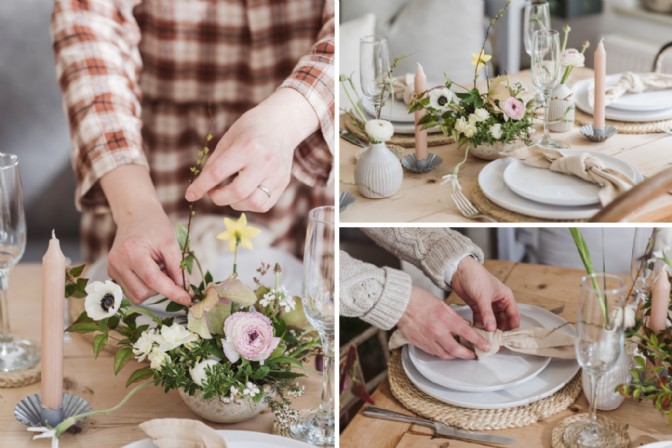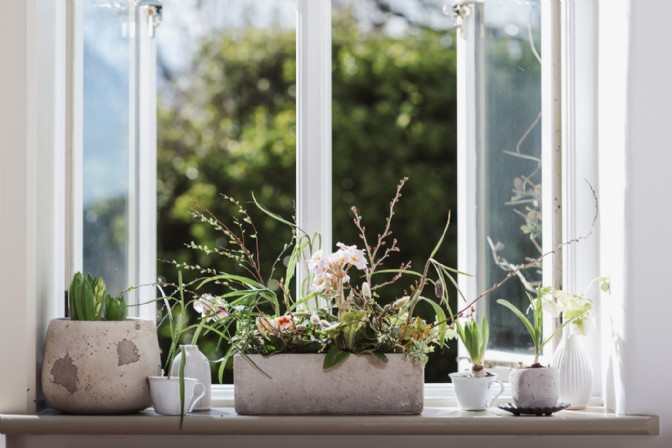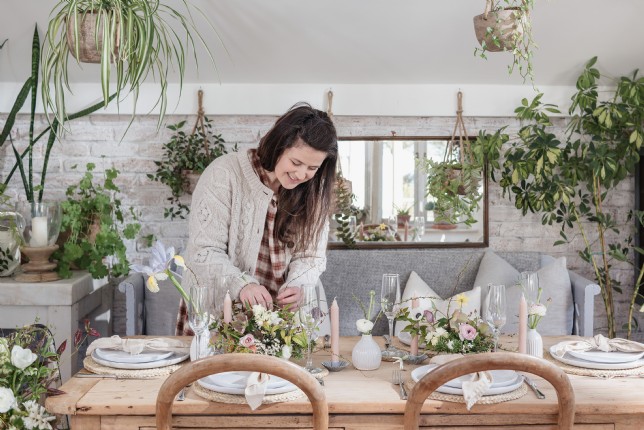As spring begins to emerge, we get ready to welcome the change of season. Spring heralds are not only the promise of new growth, but they also mark the start of flowers and colour; there may not be an abundance of blooms just yet, but if you look closely you will find some treasures from the garden to style your home and brighten any empty corners.
As a flower grower and floral designer based in North Cornwall, I grow seasonal flowers for weddings and local deliveries, and this time of year includes some of my favourite blooms: fritillaries, scented narcissus, hellebores and ranunculus along with pretty flowering shrubs, such as spirea, abelia, hebe and magnolia blossom.
Here, I share how to bring a touch of spring to your home, using Cornish retreat Gwendolyn.
Style your dining table
Make your intimate Easter dining celebrations extra special this year by incorporating new growth from the garden into your table at home. I opted for simple white crockery with rattan mats and knotted natural linen napkins to allow the flowers to take centre stage.
When styling a table, creating different heights and textures works well. Here, I have used two low bowl arrangements, with a selection of ceramic bud vases each with single floral stems and twiddly spirea foliage. The pops of pink and yellow contrast against the green of the foliage and lift the neutral tones of the simple place settings. Candles add height and interest to the table and soften the ambience, creating a warm and inviting setting.


Transform your dining room with floral chair backs
Chair back decorations aren't just for weddings; transform your dining or breakfast room with these floral chair backs using just a few items.
You will need:
- Six to eight stems of foliage
- Narcissus
- Tulips
- Hyacinth
- Twine
- Ribbon
Gather your ingredients from the garden or forage during your daily walk, here I have used a selection of foliage, including abelia, magnolia blossom and hebe. You will need a flat back so that it lies flush with the back of the chair when you attach it. Take three pieces of foliage and lay in a fan shape, then begin to carefully lay your flowers on top of the foliage framework. Continue layering your flowers, taking care not to crush any of the fleshy stems. When you are happy with the overall shape of the piece, use twine to secure the bouquet and attach it to the corner of your chair. Then cover the twine using silk ribbons, I use botanically dyed silks by Lancaster & Cornish or The Natural Dyeworks.


Use spring planters and potted bulbs to brighten living areas
These are perfect for any space in your home that needs an injection of colour and greenery. The spring planter creates a focal point for tables or windowsills anywhere in your home, then the potted bulbs are ideal for smaller surfaces. I used a cement planter then some gorgeous enamel cups from Domestic Science and they are the perfect fit for a single bulb. Once these are enjoyed inside, you can replant them in the garden for a display the following year.
You will need:
- A large planter of choice
- Vessels such as enamel cups, mugs, old candle jars, vintage terracotta plant pots or small cement planters
- A selection of bulbs and flowers in varying heights and colours; your local garden centre will have a selection of potted bulbs and plants including snakeshead fritillaries, snowdrops, hyacinths, crocuses, primroses and primulas
- Snipped flowering branches, such as pussy willow or hazel twigs
- Small foliage plants such as potted variegated ivies
- Multipurpose compost
Fill your large planter halfway with compost, then pick a selection of bulbs and flowers that have a range of heights and shapes to add structure to the arrangement. Take three plants or bulbs which have height and place one in the centre and one at either end of your planter, then, nestle a couple of smaller flowers between them and use lower flowering plants to cover the bare soil. Once you are happy with how the arrangement looks, add your flowering branches and twigs for texture.
To create the smaller potted bulbs, place a fresh sprinkling of compost in the base of your vessel then carefully remove the bulbs from their pots and shake off the soil. Place the bulb into the vessel, being careful to make sure that the roots are resting in the compost. Tuck the bulb into the vessel with more compost and water lightly. Make sure to water these every few days to ensure longer flowering of the bulbs.

Thank you to Emily from 3acre Blooms for sharing her expert floral styling tips. Find 3acre Blooms on our recommended suppliers list when booking one of our unique wedding venues in Cornwall and visit her website for more information.







